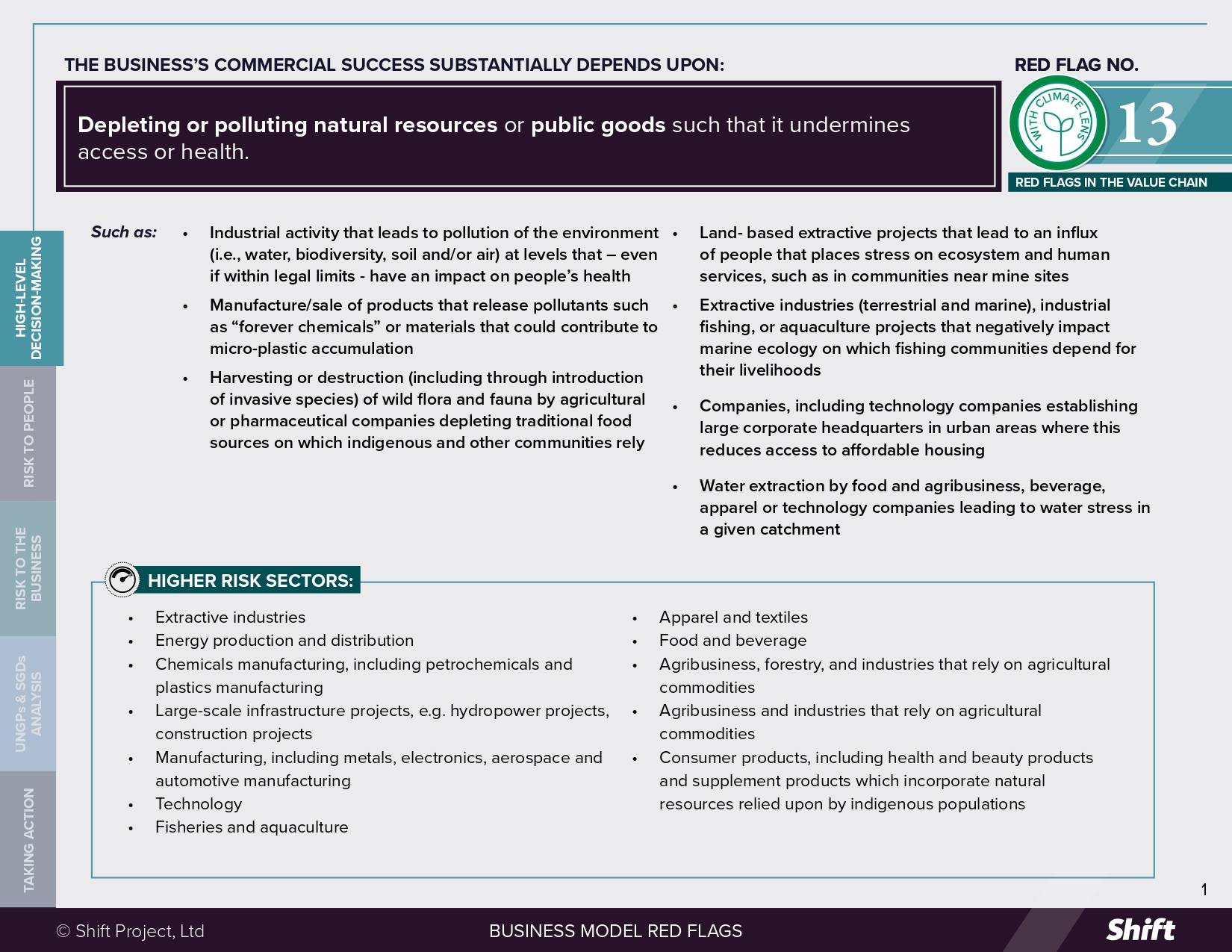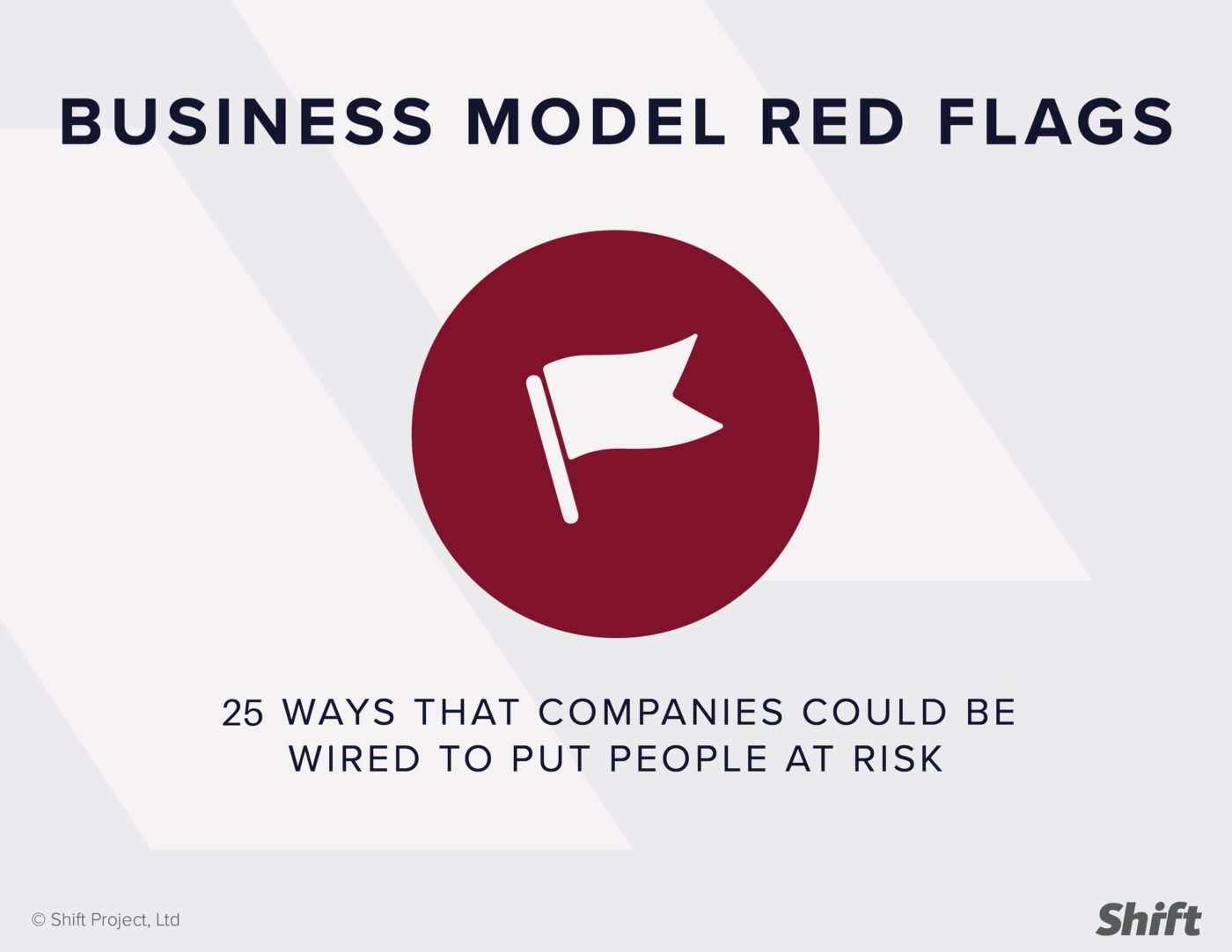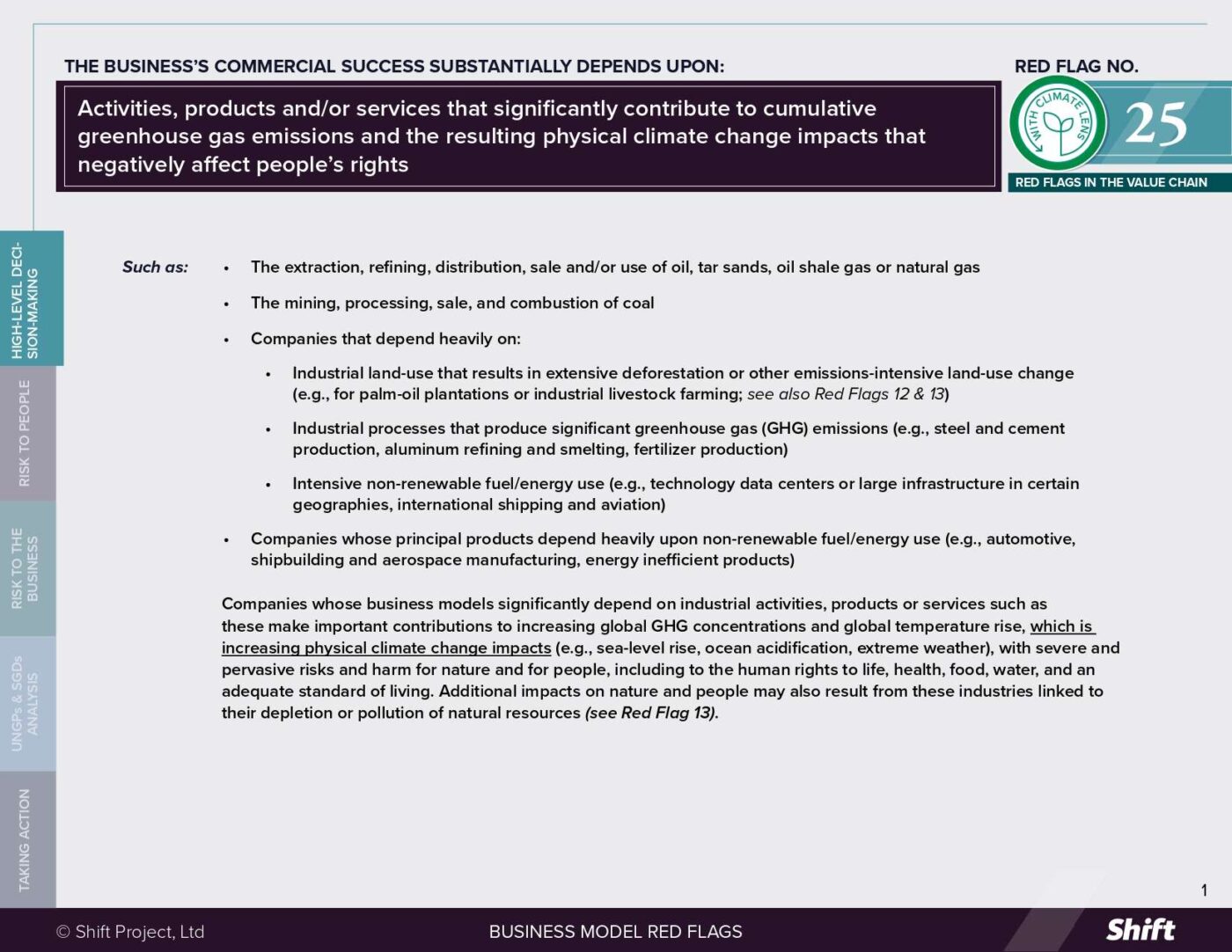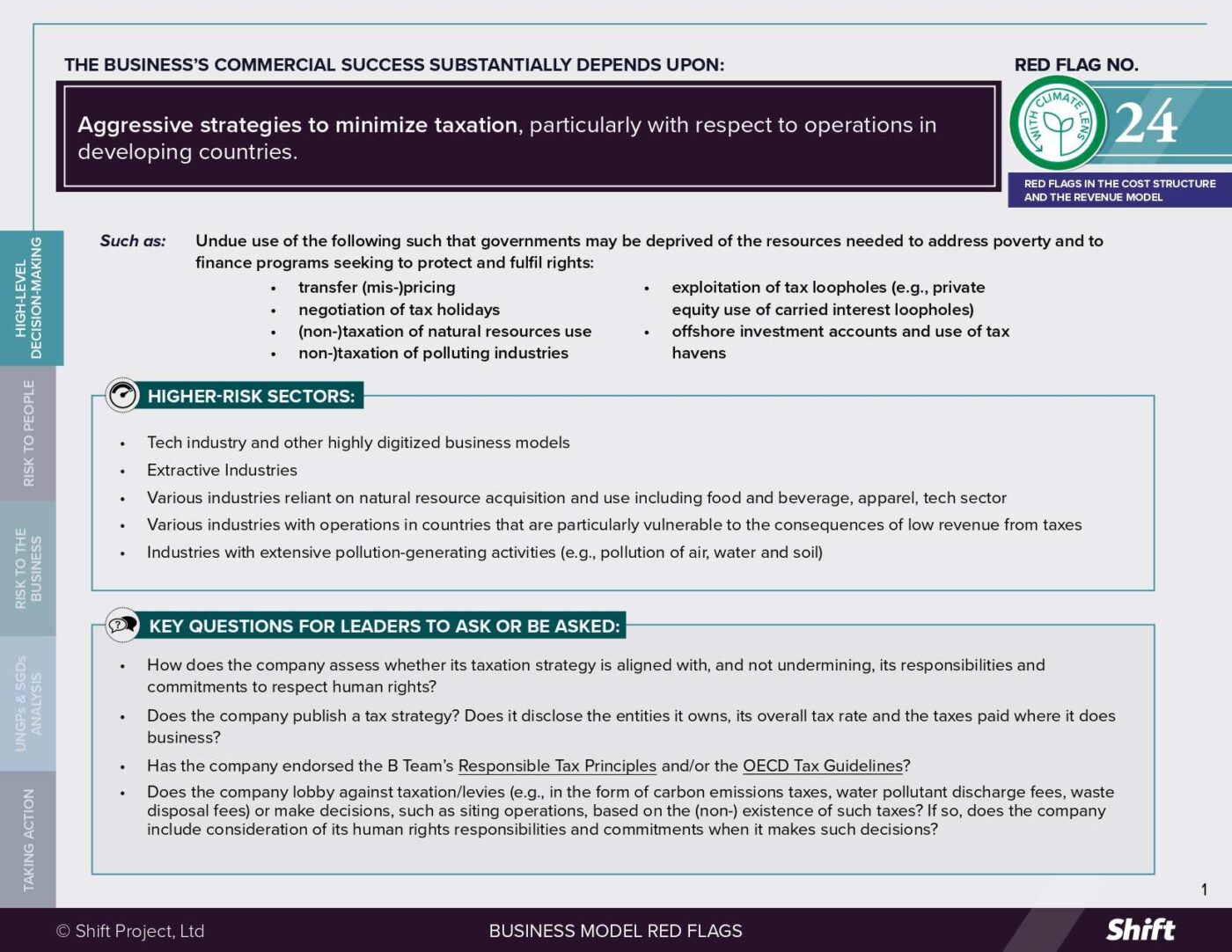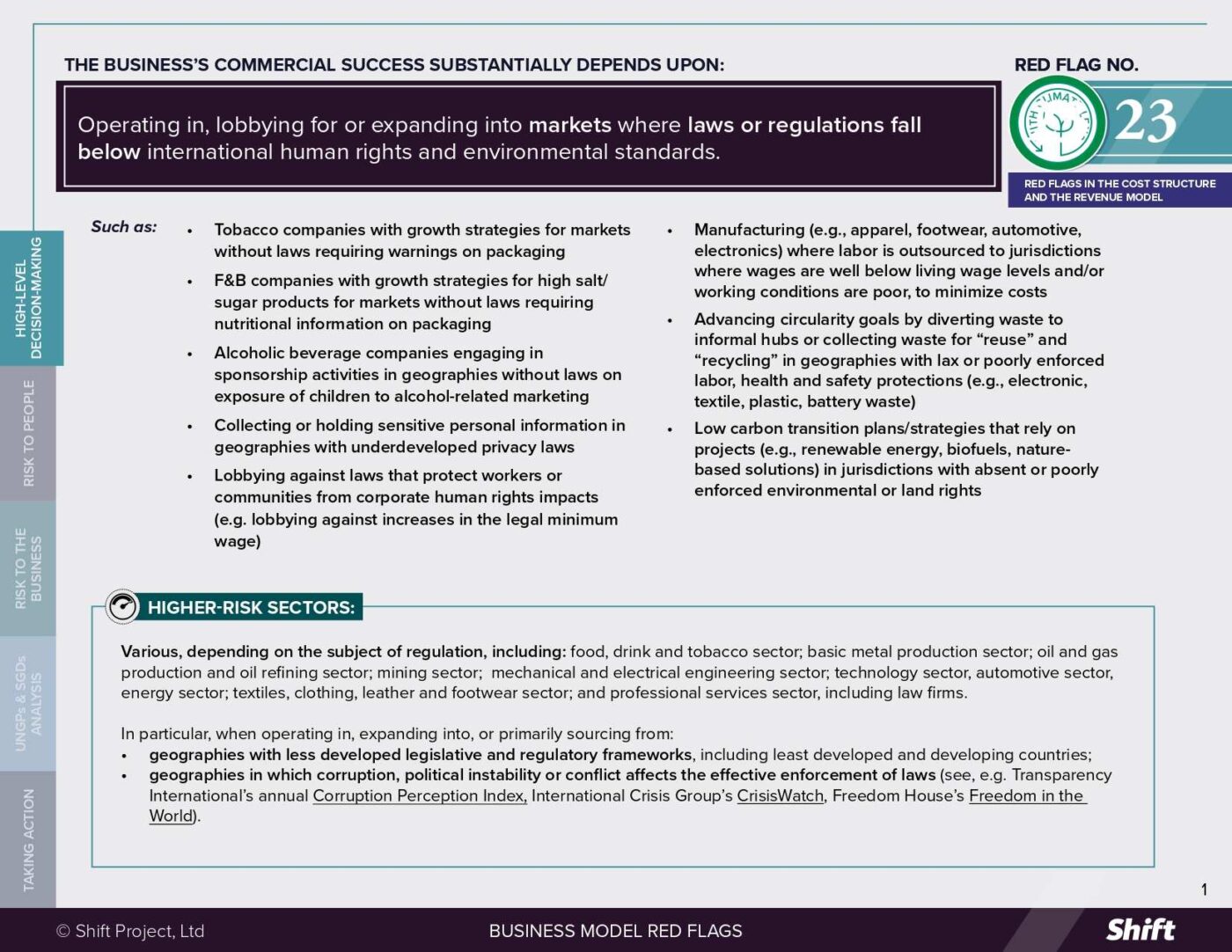RED FLAG # 13
The business’s commercial success substantially depends upon: Depleting or polluting natural resources or public goods such that it undermines access or health.
For Example
- Industrial activity that leads to pollution of the environment (i.e., water, biodiversity, soil and/or air) at levels that – even if within legal limits – have an impact on people’s health
- Manufacture/sale of products that release pollutants such as “forever chemicals” or materials that could contribute to microplastic accumulation
- Water extraction by food and agribusiness, beverage, apparel or technology companies leading to water stress in a given catchment
- Harvesting or destruction (including through introduction of invasive species) of wild flora and fauna by agricultural or pharmaceutical companies depleting traditional food sources on which indigenous and other communities rely
- Land-based extractive projects that lead to an influx of people that places stress on ecosystem and human services, such as in communities near mine sites
- Marine extractive, industrial fishing, or aquaculture projects that negatively impact marine ecology on which fishing communities depend for their livelihoods
- Companies, including technology companies, establishing large corporate headquarters in urban areas where this reduces access to affordable housing
Higher-Risk sectors
- Extractive industries (terrestrial and marine)
- Energy production and distribution
- Chemicals manufacturing, including petrochemicals and plastics manufacturing
- Large-scale infrastructure projects, e.g. hydropower projects, construction projects
- Manufacturing, including metals, electronics, aerospace and automotive manufacturing
- Technology
- Fisheries and aquaculture
- Apparel and textiles
- Food and beverage
- Agribusiness, forestry, and industries that rely on agricultural commodities
- Consumer products, including health and beauty products and supplement products which incorporate natural resources relied upon by indigenous populations
Questions for leaders
- How does the company assess whether environmental (including resource efficiency and industrial waste management), housing and other relevant laws and regulations where it operates or sources are sufficient, and sufficiently enforced, to protect human health, livelihoods and other fundamental human needs?
- How does the company assess its contributions to the cumulative impacts in a particular area?
- How does the company assess whether regulations are sufficient and sufficiently enforced when it comes to cumulative impacts from multiple users of resources, and not just for individual users? How does it do so in the case of transboundary impacts, including from “forever chemicals” or materials contributing to microplastics accumulation?
- How does the company manage and monitor its impact on the environment, including for air, water, soil and biodiversity/ecology, and how its actual or potential impacts affect people including human health, livelihoods and other human needs?
How to use this resource. ( Click on the “+” sign to expand each section. You can use the side menu to return to the full list of red flags, download this Red Flag as a PDF or share this resource. )
Understanding Risks and Opportunities
Risks to People
-
Impacts on people through resource depletion or industrial emissions into air, soil, water, and biodiversity can occur as a result of individual or collective corporate activities.
-
The activities of individual companies may, for example, overtax a resource, particularly in an existing context of scarcity. While individual corporate activity is more typically regulated than cumulative impacts (see below) this is not the case in all jurisdictions (rural areas in some geographies).
-
A company may also contribute to cumulative impacts, where it is one of several actors whose actions together result in a total impact that depletes, destroys, pollutes or otherwise damages a resource or access to that resource.
-
-
In both cases, this can lead to impacts on people’s health, livelihoods and other human needs. People most visibly and directly affected by corporate resource use or pollution can be those in physical proximity to sites of corporate activity, such as in the vicinity of extractive projects, power plants, infrastructure projects, large farms or plantations, industrial fisheries or large corporate headquarters in urban areas.
-
However, certain types of resource depletion or pollution can affect people at significant distances, including across jurisdictional boundaries. For example, air pollutants from coal and oil power generation can impact environments and people downwind from the pollution source, or overexploitation or pollution of marine resources can affect fish, marine ecology and fishing communities much further afield as pollution moves with currents and fish/ecology can have large habitation areas.
-
Industrial waste management, including of wastewater and hazardous materials (e.g., “forever chemicals”, heavy metals, and microplastic precursor materials) can have disastrous impacts on human health and the environment. Inadequate chemicals management and disposal, inappropriate product usage or product end-of-life (mis)management can lead to chemicals travelling long distances from their original source, accumulation in various organisms, biomagnification up food webs, and human exposure leading to health impacts, including various cancers.
-
For example, on microplastics, a UN report details how they are becoming “so widespread in our environment that they have been found everywhere from bottled water to Arctic snow”. Possible impacts on human health, according to the report, include lung inflammation, carcinogenicity, gene mutilation and repercussions for reproductive health. In addition, plastics make a direct contribution to climate change, accounting for 20% of total oil consumption and their manufacture, recycling and incineration is energy intensive, resulting in high carbon emissions (see also Red Flag 25).
-
-
Government authorities “frequently fail to undertake cumulative/ strategic impact assessments, and even where such assessments are undertaken, human rights information relevant to such assessments is not taken into account” (OHCHR).
-
Corporate activities may be associated with:
-
Reduced water quality or quantity for local communities (Right to health, right to safe and clean drinking water).
-
Long-term health problems amongst local people as a result of their own emissions, or as contributors to cumulative air, soil and water emissions from multiple industrial facilities concentrated into a single area (Right to health)
-
Emissions from a single factory or several factories that flow into a single waterway – reducing fish stocks, polluting the potable water supply, and undermining local livelihoods and nutrition (Right to adequate standard of living, right to food, right to safe and clean drinking water, right to clean, healthy and sustainable environment)
-
Price inflation, pressures on social services and affordable house and increased levels of anti-social behavior in towns near to or hosting extractive projects that attract a large influx (“in-migration”) of actual/aspiring workers and their families (e.g. housing, rents and access to medical services). (Right to an adequate standard of living (right to housing))
-
depletion of fish stocks, impacting local communities’ food security, as well as livelihoods of artisanal fisherman (Rights to food and health, Right to work, and Right to a clean, healthy and sustainable environment)
-
large-scale deforestation (e.g., for palm oil plantations or industrial livestock farming) jeopardizes communities’ access to clean water, food, land and breathable air while increasing exposure to disease (Rights to health, safe and clean drinking water, and a clean, healthy, and sustainable environment).
-
Scarcity of resources for indigenous or other local communities, resulting from industrial pollution of soil or water or a company harvesting natural resources for use in products (Indigenous Peoples’ rights)
-
Climate change exacerbates this Red Flag in multiple ways. Increasing frequency and severity of extreme weather events (e.g., storms, floods, droughts, heatwaves) can create new, or further intensify existing, natural resource depletion or pollution risks. For example:
-
Reduced river and stream flows during droughts concentrate pollutants, increasing their toxicity and complicating water treatment efforts
-
Floodwaters can carry industrial pollutants far beyond their original sites, spreading contamination to new areas and complicating cleanup. Overflow or leaking of industrial sites and waste storage areas, release pollutants—including heavy metals, chemicals, and untreated wastewater—into rivers, lakes, and groundwater.
-
An increasingly vicious circle across air pollution, climate change and wildfires is having increasingly detrimental impacts on human health, ecosystems and agriculture.
-
Higher water temperatures can worsen chemical reactions that create toxic byproducts in industrial wastewater, creating even more toxic and damaging impacts on ecosystem services. Further, industrial thermal pollution can further exacerbate warming, stress aquatic life and reduce water quality.
Physical climate impacts will exacerbate the impacts on local communities resulting from industrial depletion or pollution of natural resources where these resources are increasingly scarce or under threat. Some examples include:
-
In Latin America, industrial water demand coupled with multi-year droughts is compromising water availability for local communities.
-
Insect pollinators, which have been threatened by agribusiness insecticide use and air pollution for years, are now under further threat due to climate change, which can bring negative impacts for crop yields and food supply.
-
Industrial contaminants (heavy metals, microplastics) when combined with climate stresses (drought, erosion) are degrading soils critical for agriculture, with implications for smallholder farmers and agricultural communities.
Further, the transition to a lower carbon economy is also intensifying impacts on people in relation to this Red Flag. For example:
-
Mining for the critical minerals needed for renewable energy technologies, such as copper, cobalt and lithium, is depleting and contaminating water supplies in several locations globally and risks making already water-stressed areas more vulnerable.
-
The transition is also increasing the demand for land – a critical natural resource. An estimated 54% of energy transition minerals are located on or near Indigenous Peoples’ land. Similarly, the deployment of large-scale renewable energy projects can be land-intensive and many of them are already competing with other local land uses by Indigenous Peoples, customary land holders, pastoralists, forest guardians and local farmers.
Risks to the Business
-
Reputational risks: Individual company and cumulative impacts can generate considerable attention and multinational corporations are often targeted for criticism, particularly where people believe that appealing to governments may have little effect.
-
In Uruguay, Google’s plans to build a data center to service Google users worldwide met with widespread public protest and media scrutiny, due to the anticipated water use to cool the data center’s servers (estimated at 7.6m liters daily), on top of existing industry and agribusiness water demands and in the midst of a multi-year drought, linked to climate change-related prolonged water stress.
-
In 2024, Serbian protesters took to the streets and mounted road blockades in opposition to Rio Tinto’s planned lithium project, citing concerns about water and land pollution. The project’s proponents argue that the US$2.4B project could meet up to 90% of Europe’s current lithium needs for electric vehicles and mobile devices.
-
In 2014 Volkswagen was embroiled in a reputationally damaging scandal, as well as being fined the US EPA, for installing software into some of its diesel vehicles to cheat regulatory emission limits. The limits aim to reduce cumulative air pollutants which affect human respiratory health in addition to the broader environment.
-
A UNEP-FI report sets out how insurance providers and investors with businesses inadequately addressing plastic pollution risks within their portfolios can lead to physical, transition, liability and reputational risks for the financial institutions.
-
-
Legal, Financial and Regulatory risks: Companies that do not address their potential or actual impacts can face legal action for their contribution or preemptive legal action to avoid company activities that are perceived to negatively impact local communities or other stakeholders. Further, even without legal action, concerns over corporate resource use or emissions can lead to shutdowns or regulatory action with significant financial impacts.
-
Over the past 25 years nearly 10,000 court cases have been filed in the USA alleging harm from exposure to “forever chemicals” (per- and polyfluoroalkyl substances or PFAS). Some 140 industries are facing litigation, with settlements in those cases so far totaling $16.7 billion. European litigation is also on the rise with more than 2,000 sites identified as far exceeding “safe” PFAS pollution levels.
-
3M reached a US$10.3B settlement with several US public water authorities in 2023, to resolve water pollution claims tied to PFAS contamination of the public water supply by their processing facilities. In response to public and regulatory pressure, the company announced it would cease manufacturing PFAS and phase them out of all its products by 2025.
-
In 2022, Shell agreed to pay US$16M to four Nigerian farmers and their communities to compensate for damage allegedly caused by pollution coming from leaks in its oil pipelines.
-
In Tamil Nadu, India, public outrage over the potential water shortages and industrial pollution led to state authorities cancelling the planned construction of a Coca-Cola bottling plant in 2015.
-
In July 2024, a California court ruled that the Earth Island Institute’s lawsuit against major consumer goods companies (including Coca-Cola, P & G and PepsiCo), for allegedly creating a public nuisance from plastic packaging polluting California’s waterways, could proceed.
-
A multi-billion dollar mine expansion in Peru was abandoned over community concerns about water stress and environmental pollution. Attempts by Newmont to resurrect the project have been met with public opposition and court rulings against the mine’s expansion.
-
In 2024, following a multi-year dispute and Supreme Court ruling in Norway over Europe’s largest onshore wind farm and the right of Indigenous Peoples to raise reindeer on the land, Statkraft finally settled with the local Sami people for a share of energy produced, new land for reindeer grazing and a NOK 5 million grant.
-
Freeport-McMoRan’s Grasberg mine, which had, for years, been releasing untreated, toxic mine tailings directly into the river (with devastating impacts for local water supply and food security), was faced with new Indonesian standards in 2018, which required over 90% of tailings to be stored on land going forward. Following the company’s response that compliance with these new standards “cannot be done”, the company’s shares dropped by 18.2% and rendered Freeport that day’s worst performer on the S&P500.
-
In Taiwan, drought conditions, which are expected to be further exacerbated by climate change, have pitted the country’s powerful semi-conductor industry against Taiwanese rice farmers, significantly raising the profile of the issue. When the government issued tighter restrictions on water use in 2021, the output of the world’s biggest contract chipmaker, TSMC, was put at risk.
-
In the US, a Washington State ban on bottled water companies tapping into groundwaters sources did not pass through a state House committee, but it nonetheless raised local and national lawmakers’ scrutiny of water extraction by the bottled water industry. In 2020, US House Democrats launched an investigation into bottled water industry practices.
-
Norwegian ship owner Georg Eide was sentenced to six months unconditional imprisonment and his company fined 2million NOK (€200,000) for having assisted scrap dealer Wirana in attempting to scrap a vessel on a Pakistan beach where there was no capacity or infrastructure to recycle or dispose of hazardous wastes in a safe and environmentally sound manner.
-
What the UN guiding principles say
The State has a duty to protect its people from harm to their health and other human rights, through appropriate regional planning and/or industry-wide regulation. However, States are not always able or willing to manage impacts: corruption may interfere with the management of single corporate impacts, for example, or the government may have a lack of technical capacity to understand and manage complex cumulative impacts. Notwithstanding, companies have a responsibility to address such impacts.
Cumulative impacts (also known as “collective impacts” are one of the two ways in a company can contribute to impacts (see OHCHR at page 16).
Situations can arise in which companies are directly linked to such impacts by way of their products, services or business relationships. Examples would include food and beverage companies that reply on agribusiness where resource-based impacts occur, and companies in various industries that rely on other commodities extracted in association with such impacts. In some circumstances, foreseeability of the relevant impacts and a lack of mitigation measures can, over time, lead to a situation of contribution.
Possible Contributions to the SDGs
Addressing impacts on people associated with this red flag indicator can contribute to a range of SDGs depending on the impact concerned, for example:
-
SDG3: Good health and well-being, in particular Target 3.9: By 2030, substantially reduce the number of deaths and illnesses from hazardous chemicals and air, water and soil pollution and contamination
-
SDG 6: Clean water and sanitation, in particular Target 6.3: by 2030, improve water quality by reducing pollution, eliminating dumping and minimizing release of hazardous chemicals and materials, halving the proportion of untreated wastewater. And Target 6.4: by 2030, substantially increase water-use efficiency across all sectors and ensure sustainable withdrawals
-
SDG 12: Ensure sustainable consumption and production patterns, in particular: Target 12.6: encourage companies, especially large and transnational companies, to adopt sustainable practices; and Target 12.2: by 2030, achieve the sustainable management and efficient use of natural resources
-
SDG 15: Protect, restore and promote sustainable use of terrestrial ecosystems, sustainably manage forests, combat desertification, and halt and reverse land degradation and halt biodiversity loss
Taking Action
Due Diligence Lines of Inquiry
-
How do we assess whether our use of and impact on natural resources could impact vulnerable populations that need to benefit from those same resources?
-
Do we include in our assessments, the potential for contributing to these kinds of harm through cumulative impacts and transboundary impacts?
-
Do we understand the degree to which climate change or the low carbon transition could exacerbate our use or pollution of natural resources?
-
How do we assess baseline conditions, measure, monitor and respond to the impact of our activities, products and services, including when added to other existing or planned projects and developments?
-
How do we engage with regulatory authorities and others to understand whether and how they mitigate these risks and measure the results?
-
Where these risks exist, what sort of leverage do we have to influence the situation and how might we increase that leverage at the start of any project or investment? Have we considered ways of increasing our leverage by acting in collaboration with others?
-
Have we considered – with reference to the latest technology – how we can reduce reliance on plastic/PFAS/ VOC use in, or leaching/off-gassing from, our products and/or their packaging?
Alternate Models
-
Closed-loop business models “keep products, components and materials at their highest utility and value – reducing the need for extracting and processing new resources and, in the process, cutting the related impacts on the environment” and people (UNGC Project Breakthrough).
-
Some examples of resource recovery-based business models include:
-
India-based Phool has developed a process that converts harmful flower waste (which is a significant contributor to freshwater pollution in India) to “bio-leather”, which not only diverts harmful waste from freshwater sources, but also represents an alternative to conventional animal leather, the production of which is another significant pollution source.
-
Redwood Materials uses a hydrometallurgy process to recycle battery manufacturing scrap into raw nickel, cobalt and commercial-scale source of lithium, resulting in a significant reduction of carbon dioxide emissions, energy consumption and water use.
-
-
Danone treats three key resources – water, milk and plastic – as part of closed loops, with a senior executive overseeing Danone’s cross-divisional, cross-functional, Strategic Resources Cycles Unit.
-
OceanSafe is a textile technology company focused on creating circular, biodegradable alternatives to conventional polyester. Rather than manufacturing final garments, OceanSafe supplies fibers and yarns to partner brands and mills, enabling them to produce products that are safe for both natural systems and recovery/reuse systems. One of their products is biodegradable (>93% in seawater within 99 days) and performs comparably to standard polyester.
-
Patagonia has, over time, increasingly oriented its business model toward reducing its environmental emissions and waste production and the negative impacts on people including workers, and those working in their supply chain.
Mitigation Examples
Water quality and quantity
-
The CEO Water Mandate: Shift, UN Global Compact and the Pacific Institute (Mandate secretariat) partnered on bringing a UNGPs lens to company efforts to respect the human rights to water and sanitation. Endorsers of the CEO Water Mandate commit to continuous progress against six core elements of stewardship and in so doing understand and manage their own water risks.
-
The Water Resilience Coalition, an initiative of the CEO Water Mandate aims to bring together a critical mass of companies to build water resilience in their operations and supply chains, as well as investing in collective action to improve water resilience in the most water-stressed basins world-wide.
-
A company in the food and beverage industry considering entry into Myanmar identified, among other things, potential impacts that could arise from reliance on extracted groundwater at one plant near a village which also depended on groundwater for domestic and livelihood use. The company’s actions in response included upgrading wastewater treatment stations at both plants and conducting assessments of local water sources. (See further CEO Water Mandate at p.78).
-
Merck, a global pharmaceutical manufacturing company, has instituted closed loop cooling systems at over half of its facilities worldwide in order to reduce its freshwater use by approximately 3.3 billion gallons per year.
-
A partnership between Kraft Heinz, a global food manufacturer and Ecolab, an industrial water efficiency technology, resulted in 51 million gallons of water saved (reducing its intake of local freshwater) and an overall $1.2 million in resource efficiency gains.
Chemicals
-
In 2016, IKEA instituted a medium- to long-term chemical strategy, which covers more than 1000 suppliers and aims to identify and phase out harmful substances from the approximately 10,000 products sold by the company. To date the company has phased out PFAS, BPA, benzophenone, and titanium dioxide. The company is focused on increasing transparency in the supply chain and with customers; evaluating all materials, phasing out hazardous materials, ensuring suppliers are aligned with IKEA’s values and increasing broader awareness of the company’s chemical work.
-
A cradle to cradle certification has been developed to encourage companies to design products for the circular economy (i.e. intentionally designing with reuse and/or recycling in mind) with the aim of reducing the negative impacts from materials on people and the environment, such as reducing plastic wastes and removing potentially harmful chemicals use beyond legislative requirements.
Cumulative impacts
-
Rio Tinto’s, Why human rights matter: a resource guide for integrating human rights into Communities and Social Performance work at Rio Tinto (page 37) describes how the company incorporates its potential contribution to cumulative human rights impacts into its assessment of the social impact of mining, metals and associated operations.
Resource use
-
The “Eco-Industrial Park” model, wherein multiple firms collaborate within a given geographic location to more efficiently use natural resources, as well as reduce waste generation and emissions, has been found to be successful when there is very active community involvement and engagement in the design, construction and operational phases of these parks.
Other Tools and Resources
General
-
UNEP Finance Initiative (2024) Human Rights Toolkit provides insight and due diligence lines of inquiry based on company sectors. Those related to agriculture, manufacturing, minerals and metals extraction, as well as the digital economy are particularly relevant in the context of this business model risk. UNEP also provides a human rights and environment due diligence guide (currently in draft).
-
UN Global Compact provides comprehensive guidance for business on inter-related human rights and environmental risks and due diligence considerations. Useful case studies and links to further sources of guidance are provided.
-
UN Development Program (2024) Practical Tool for Business on Human Rights Due Diligence and the Environment (HRDD+E)
-
The UN Special Rapporteur on the human right to a clean, healthy and sustainable environment provides various relevant resources.
Cumulative Impacts
-
UN Global Compact (2014) Cumulative Impacts on Human Rights: UNGC webinar addressing the “challenges and best practices in respect of cumulative human rights impacts.” Includes contributions from UNU, Shift, First Peoples’ Worldwide, Rio Tinto and Anglo American.
-
Cumulative Human Rights Impacts in the Maplecroft/ UN Global Compact Human Rights and Business Dilemmas Forum: Contains scenarios, examples, case studies and suggestions for business in relation to the question, “How should a responsible company identify and address its incremental contribution to a cumulative human rights impact, particularly an impact on an individual or a community that is the result of the combined actions of several actors?”
-
IFC (2013) Good Practice Handbook Cumulative Impact Assessment and Management: Guidance for the Private Sector in Emerging Markets: Contains guidance concerning cumulative impact assessment in the context of an ESIA (environmental and social impact assessment) or stand-alone CIA (cumulative impact assessment).
-
UN Working Group on Business and Human Rights Expert Roundtable on Cumulative Human Rights Impacts.
-
Danish Institute for Human Rights (2014) Human rights impact assessment guidance and toolbox: Has a dedicated section on analyzing impacts, including cumulative impacts.
-
Union of Concerned Scientists (2024) Cumulative Impacts Policies: A Promising Approach to Environmental Protections and Cumulative Impacts Guide. These resources provide insight into cumulative impacts, what they are, where they originate from, the impacts they can have for public health and how communities can take action to address them.
Sector specific
-
Mega-infrastructure investment: OHCHR (2017) Baseline Study on the Human Rights Impacts and Implications of Mega-Infrastructure Investment (pp. 50 and 61).
-
Shipbreaking: Guidance on safe and clean ship breaking
-
Mining: BHRRC (2025) Transition Minerals Tracker
-
Oil & Gas: Amnesty International (2023) Fatal fuels: Why human rights protection urgently requires a full and equitable fossil fuel phaseout
Water pollution & usage:
-
The CEO Water Mandate’s Water Action Hub “raises awareness, catalyzes collaboration, and scales critical lessons on water sustainability around the world.” It catalogues over one thousand water-related projects, including distilling lessons learned on many projects.
-
The Ceres Valuing Water Finance Initiative Benchmark assesses company performance on water pollution and use across the high-tech, food, beverage, and apparel sectors.
Deforestation
-
Forest 500 (2024) The human rights blindspot in deforestation action
-
Swedwatch (2019) Undercutting Rights: Human rights and environmental due diligence in the tropical forestry sector. A case study from Cameroon
Forever Chemicals
-
European Environment Agency (2024) What are PFAS and how are they dangerous for my health?
Plastics, including microplastics
-
Plastic collective (2023) How Can Businesses Reduce Plastic Use and Improve Their Plastic Footprint
-
Oceanwise (2025) A Guide For Businesses On Best Plastic Reduction Practices
-
UNEP (2019) Microplastics
-
UNEP, UNEP-FI and PSI (2019) Unwrapping the risks of plastic pollution to the insurance industry
-
UN Forum on Business and Human Rights (2023) How can the UN Guiding Principles end plastic pollution?
Citation of research papers and other resources does not constitute an endorsement by Shift of their conclusions.

 Business Model Red Flags
Business Model Red Flags  Tool for Indicator Design
Tool for Indicator Design 